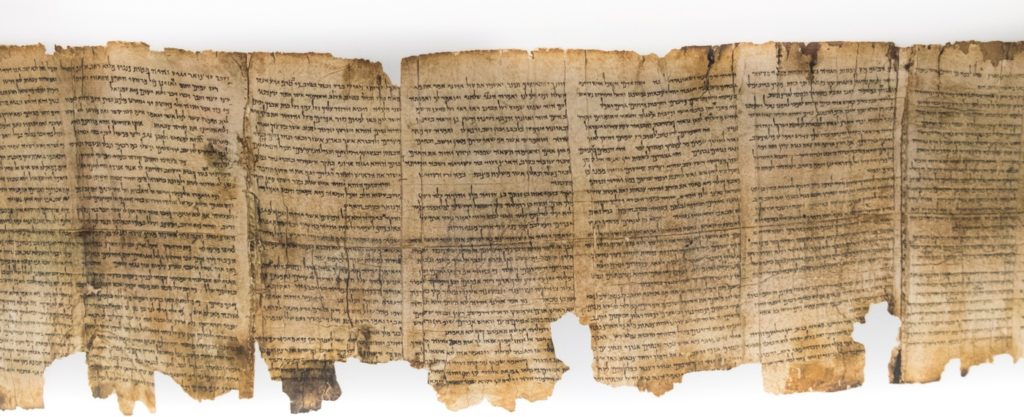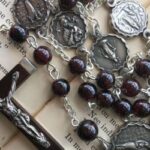Israeli Researchers Unearth New Dead Sea Scroll Fragments, A 6,000-year-old Child, and a 10,500-year-old Basket

Mary Rose Somarriba
“Who lived 6,000 years ago?” I asked my husband upon reading the news the other day. “Adam and Eve?” he ventured.
The question came to mind given the recent news from Israel, where recent excavations revealed some stunning findings. Among them are a mummified skeleton of a child dating back 6,000 years, a well preserved basket dating back 10,500 years, and new fragments of the Dead Sea Scrolls dating back 2,000 years.
Over past decades, Israeli excavations have been foiled by pirating explorers looking for treasures that are sold on the black market. But in the past year, Israeli archeologists have managed to outpace robbers, claiming these most stunning findings that are only now being examined for further information.
The Judean desert caves where Israeli archeologists made the discoveries, are known for a dry, arid climate, which is ideal for preserving items from damage that could come from moisture. The cave where the Dead Sea Scroll fragments were found has been nicknamed the “Cave of Horror,” or “Horror Cave,” a name coined in the 1980s, when a number of skeletons were found in the location, dating back to a period 1,900 years ago, when Jewish rebels and their families hid from the Romans in the caves, who starved them out.
Parts of the desert areas where artifacts continue to be found, are difficult to reach and govern, so in an effort to get ahead of robbers, the Israeli authorities began a methodical, comprehensive survey of the cliffs, gorges and caves in 2017. “Aided by modern tools such as drones that could search every nook and cranny, three teams made up of four people each mapped and scoured about 50 miles of cliff face running the length of the Dead Sea,” the New York Times reports. “Over 2,000 years, parts of the terrain have collapsed, creating deep chasms.”
The Dead Sea Scrolls were first discovered in the 1940s and 1950s, from 11 caves about one mile west of the Dead Sea. They include fragments of text mostly written in Hebrew, but with some in Aramaic, Greek, Latin, and Arabic. Most of the Dead Sea Scroll texts found contain copies of the Hebrew Scriptures, while some others considered apocryphal texts, from books not considered a part of the Hebrew Bible and sectarian manuscripts.
The Dead Sea Scroll texts found in this latest excavation appear to be written in Greek by two scribes, but the name of God is written in ancient Hebrew. After connecting the fragments, excavators have found 11 verses from Zechariah including this one:
“These are the things you are to do: Speak the truth to one another, render true and perfect justice in your gates. And do not contrive evil against one another, and do not love perjury, because all those are things that I hate—declares the Lord.”
Oren Ableman, a member of the Antiquities Authority team who conserved and studied the new fragments, said at the Museum of Israel, the concept of equal justice for all contained in the fragments’ verses “are meaningful to people to this very day.”
“The Holy Land is filled with biblical references come to life,” The Tennessee Tribune explained in a recent article surveying the archeological findings surrounding the last days of Jesus Christ, preceding the Easter season still being celebrated by Christians around the world this month, and starting the first weekend in May this year for Orthodox Christians. “Advances in radiocarbon dating have given archeologists new methods to accurately date the origins of ancient sites. The Israel Science Foundation funded a team of archeologists in Jerusalem to embark on a four-year project to identify ancient ruins in the city by measuring the decay of radiocarbon to nitrogen,” the report explains.
Among the latest technologies assisting explorers is Artificial Intelligence (AI) technology, which according to a study published in the archeological journal PLOS ONE, revealed a text of Isaiah from the Dead Sea Scrolls, long believed to be written by one scribe, has been found to have been written by two scribes. “Demonstrating that two main scribes, each showing different writing patterns, were responsible for the Great Isaiah Scroll, this study sheds new light on the Bible’s ancient scribal culture by providing new, tangible evidence that ancient biblical texts were not copied by a single scribe only but that multiple scribes, while carefully mirroring another scribe’s writing style, could closely collaborate on one particular manuscript,” the researchers said. “By identifying individual scribes from the differences in their penmanship, archaeologists may be able to piece together the links between fragments of other scrolls and gain a better insight into their origins,” the Times of Israel reports.
The findings that continue to be made in the region, aided by advances in technology, remain undergirded by a timeless human desire for exploration and perhaps even a connection with the divine.
When archeologists were unearthing the 10,500-year-old lidded basket, dating to the pre-pottery Neolithic period, they were curious what they’d find inside. “We were very curious to see what was inside when we opened the lid,” said Naama Sukenik. “But it turned out to be empty, save for a bit of sand,” the New York Times reports.
It would seem the archeologist life mirrors much of the Scripture-reading life. The more we dig, the more we find, and the more it can draw us on a journey to dig deeper.



